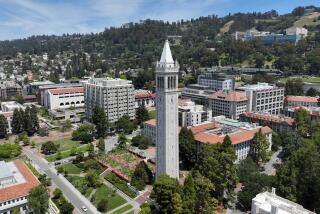Today’s Agenda
- Share via
As California developed and expanded its envy-of-the-nation higher education system during the 1960s and ‘70s, a guiding principle was universal access. True, the UC system was competitive, sitting atop the pyramid, and the less expensive Cal State system didn’t admit everyone, either. But just about all comers were welcome in the state’s community college system, which grew from 340,000 students in 1960 to more than 1.3 million in 1977.
So cheap to attend that they were nearly free, like an extension of high school, the two-year community colleges were regarded as an engine of California’s then-booming prosperity: They provided job training, fed students upward into the four-year schools and prepared people who already had degrees for new careers.
Now, between budget cuts that restrict course offerings and fee hikes that pinch students, the idea of true universal access is dimming.
In a special Voices page on the Community Colleges, a journalism professor whose life was turned around by a community college education gives vivid thanks that he’s now a college teacher with a Ph.D. instead of remaining a pizza delivery guy.
The president of Santa Monica College gives his maverick view that what’s actually strangling the two-year schools is state regulation. Set us free to compete for students, he says, and the community colleges will shine.
On a more nuts-and-bolts level, students from all over Southern California tell us in Platform what problems the fee hikes and restricted course offerings are causing, and what ingenious strategies they’re using to get the most from what’s left.
*
A year after the L.A. riots, a young Korean-American woman who can’t get the flames and hatred out of her mind sets down, in Community Essay, some thoughts for the next generation. The animosity between African-Americans and Korean-Americans that led to so much destruction last year can only be overcome by skilled communication, writes Sharon J. Bae, and the Korean community lacks these communicators. “Here is the result of our culture, which emphasizes studying over socialization . . . and conformity over individualization.” She urges families to “encourage thought, creativity and expression in order to have appropriately eloquent spokesmen for our community”--spokesmen who can create the kind of understanding that melts away hate.
*
What are the ingredients of a safe community? Are more police crucial? So far, the San Gabriel Valley community of Monterey Park has kept a low crime rate, even with a small tax base that won’t pay for more police. In the Neighborhood profiles the town’s prevention-oriented approach, which includes encouraging business owners and residents to be the eyes and ears of police.
In Second Opinion, a Vietnamese-American official proposes automatic deportation of immigrant law-breakers. And a Sentinel editorial says African-Americans face a more personal ordeal with the the coming Denny trial.
More to Read
Sign up for Essential California
The most important California stories and recommendations in your inbox every morning.
You may occasionally receive promotional content from the Los Angeles Times.










